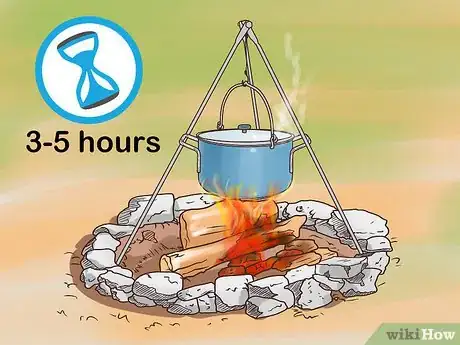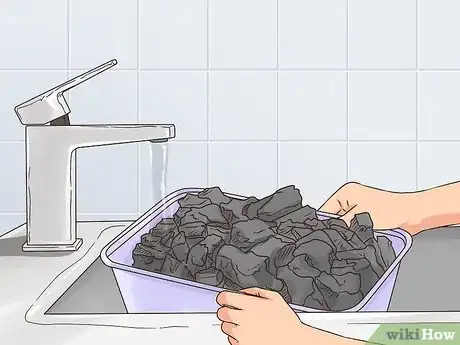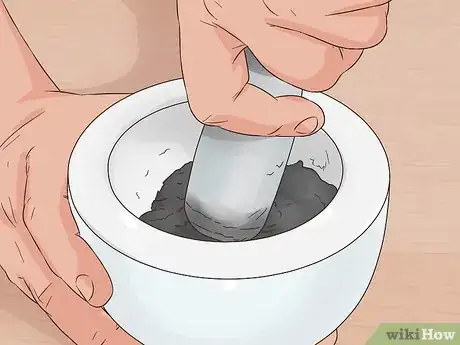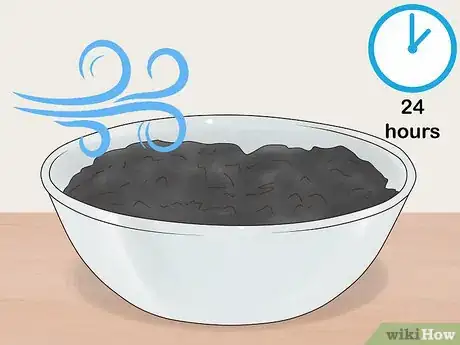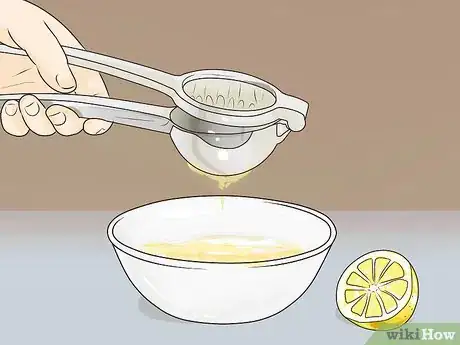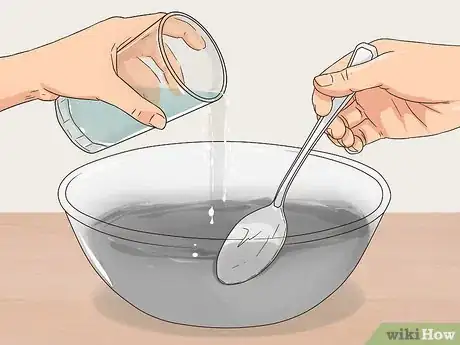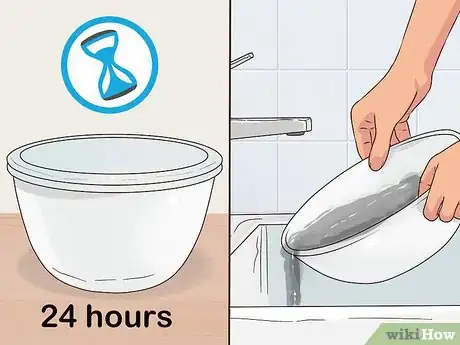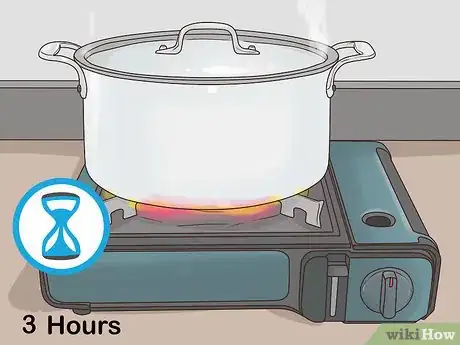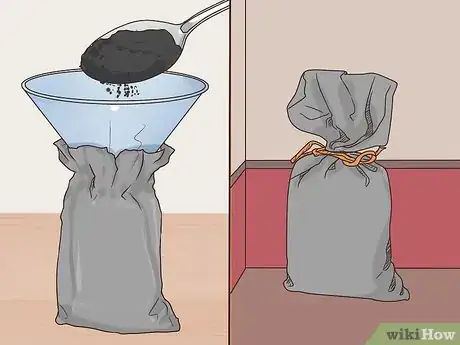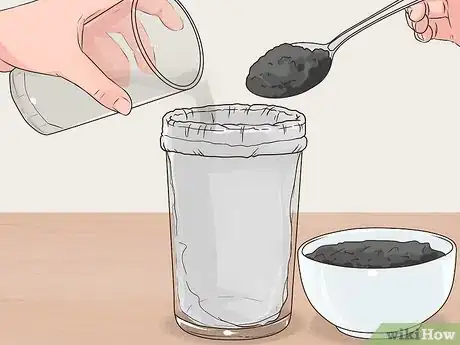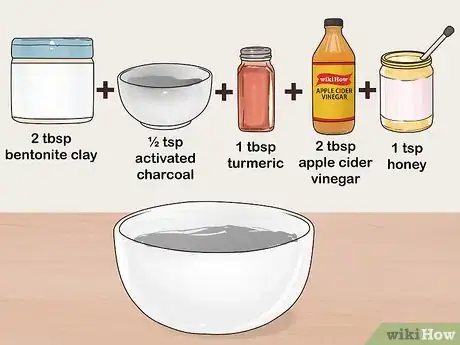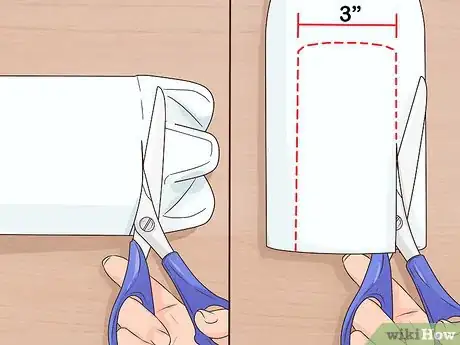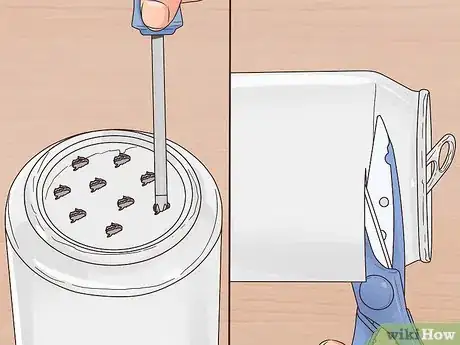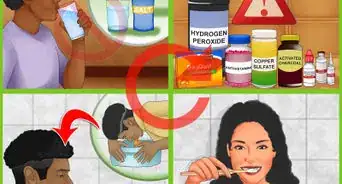This article was co-authored by Bess Ruff, MA. Bess Ruff is a Geography PhD student at Florida State University. She received her MA in Environmental Science and Management from the University of California, Santa Barbara in 2016. She has conducted survey work for marine spatial planning projects in the Caribbean and provided research support as a graduate fellow for the Sustainable Fisheries Group.
There are 8 references cited in this article, which can be found at the bottom of the page.
wikiHow marks an article as reader-approved once it receives enough positive feedback. This article received 11 testimonials and 90% of readers who voted found it helpful, earning it our reader-approved status.
This article has been viewed 482,029 times.
Activated charcoal, sometimes called activated carbon, is useful for purifying contaminated water or polluted air. In emergency situations, activated charcoal can be used to remove dangerous toxins and poisons from your body. Before you can activate the charcoal, you’ll first need make homemade charcoal by burning wood or fibrous plant material. Then you’re ready to add activating chemicals, like calcium chloride or lemon juice, and complete the activation process.
Steps
Making the Charcoal
-
1Build a medium-sized fire in a safe area. An outdoor fire will likely be the easiest for making activated charcoal, but you can also do this in your home fireplace. The fire should be hot enough to cause wood pieces to burn.[1]
- Take safety precautions when lighting a fire and always keep a fire extinguisher nearby.
-
2Pack a metal pot with small pieces of hardwood. If hardwood is not available, you can substitute almost any dense, fibrous plant material, like coconut shells.[2] Insert your hardwood pieces or plant material into a metal pot, then cover it with a lid.
- The lid of your pot should have a vent hole, though airflow to the inside of the pot should be limited throughout this process. You could use a camp cookware kettle so the air can escape through the spout, for instance.
- The material you burn should be as dry as possible before you put it in the pot.[3]
Advertisement -
3Cook the pot on an open fire for 3 to 5 hours to make charcoal. Set the lidded pot on the fire. As the material cooks, you should see smoke and gas escape from vent hole in the lid. Doing this will burn away everything from the material except the carbon (charcoal) in it.[4]
- When no more smoke or gas seems to be coming from your pot, it’s likely finished cooking.[5]
-
4Clean the charcoal with water once it cools. The charcoal now in your pot will stay hot for a while. Give it plenty of time to cool down. When it’s cool to the touch, transfer the carbon to a clean container and rinse it with cool water to remove ash and any remaining debris, then drain the water.[6]
-
5Grind up the charcoal. Transfer the cleaned charcoal to a mortar and pestle and grind it up into a fine powder. Alternatively, you could put the carbon in a durable plastic bag and crush it up into a fine powder with a tenderizing mallet or a hammer.
-
6Allow the charcoal powder to air dry completely. If you used a plastic bag, transfer the powder to a clean bowl, otherwise you can leave it in the mortar. In about 24 hours, the powder should be dry.
- Confirm the dryness with your fingers; the powder should be fully dry before you move on.[7]
Activating the Charcoal
-
1Combine calcium chloride and water in a 1:3 ratio. Be careful when you mix these substances; doing so will cause the solution to get very hot. You’ll need enough of the solution to cover the charcoal completely. For normal-sized batches of charcoal, 100 g (3.5 oz) of chloride mixed with 1.3 cups (310 ml) of water should be enough.
- Calcium chloride can be bought at most hardware stores, home centers, and general retailers.
-
2Use bleach or lemon juice as an alternative to the calcium chloride solution. If you can’t find calcium chloride, you can substitute it for bleach or lemon juice. Just use either 1.3 cups (310 ml) of bleach or 1.3 cups (310 ml) of lemon juice instead of the calcium chloride solution.[8]
-
3Stir together the calcium chloride solution and charcoal powder. Transfer the dry charcoal powder to a stainless steel or glass mixing bowl. Add the calcium chloride solution (or the lemon juice or the bleach) to the powder in small increments, stirring it with a spoon as you do so.
- When the mixture reaches paste consistency, stop adding the solution.[9]
-
4Cover the bowl and let the charcoal sit for 24 hours. Cover the bowl and allow it to sit untouched. After that, drain as much of the remaining moisture from the bowl as possible. At this point, the charcoal should be wet, but not saturated.
-
5Cook the charcoal for another 3 hours to activate it. Return your charcoal to the (cleaned) metal pot and put it back on a fire. The fire will need to be hot enough to boil water for the charcoal to activate. After cooking for 3 hours at this temperature, the charcoal will be activated.[10]
Using Activated Charcoal
-
1Understand how activated charcoal works. Activated charcoal is useful for removing bad smells, bacteria, pollutants, and allergens from air and water. It works by trapping odors, toxins, bacteria, pollutants, allergens, and chemicals into the numerous tiny pores within the charcoal.[11]
-
2Purify the air in your home. Wrap some activated charcoal in a linen sheet or cloth, then place the charcoal wherever it’s needed. If you don’t have linen, choose a tight-weave breathable fabric, like cotton.[12]
- Avoid using fabric that has a detergent or bleach smell. The charcoal will absorb these smells, too, decreasing its effectiveness.
- For improved air purification, position a fan so it blows air over the charcoal. As air passes over the charcoal, it will be purified.
-
3Make a charcoal water filter with a sock. Store bought water filters can be expensive, but you can achieve the same water purity inexpensively by making your own water filter. Take a clean sock that doesn’t smell of detergent or bleach, insert the activated charcoal, and clean water by pouring it through the sock.[13]
-
4Make a clay-charcoal facial masque. In a small mixing bowl, combine 2 tablespoons (30 ml) of bentonite clay, 1⁄2 teaspoon (2.5 ml) of activated charcoal, 1 tablespoon (15 ml) of turmeric, 2 tablespoons (30 ml) of apple cider vinegar, and 1 teaspoon (4.9 ml) of honey. Then add water a little at a time to the mixture until it is smooth.
- This masque is known for pulling out toxins and unclogging pores.
- The natural ingredients used in this masque will be safe for nearly all skin types.
- Apply the masque in a thick layer to your face for 10 minutes, then rinse it away.
-
5Treat bloating and gas with activated charcoal. Add 500 milligrams (0.02 oz) of powdered activated charcoal to 12 fluid ounces (350 ml) of water. Drink this mixture before gas producing meals or when you start feeling gassy and bloated to alleviate the symptoms.
- Taking charcoal with non-acidic juice (like carrot) will be more pleasant than taking it plain. Avoid acidic juices (such as orange or apple juice) which will make the charcoal less effective.[14]
Making an Activated Charcoal Mask Filter
-
1Fashion a mask from a plastic 2 L (68 fl oz) bottle. Use scissors to cut the bottom off a 2 L (68 fl oz) plastic bottle. Then remove a 3-in (7.3-cm) wide panel from one side of the bottle. The panel will extend from the cut off bottom to where the neck of the bottle begins to curve toward its spout.
- The plastic may be jagged where it was cut with scissors. Use medical tape along the cut edges of the bottle for padding.
-
2Create a filter chamber with an aluminum can. Poke breathing holes into the bottom of an aluminum can with scissors or a screwdriver. After that, cut off the top of the aluminum can with a kitchen can-opener.[15]
- Be careful when handling the cut metal of the can. It is often sharp enough to easily cause cuts. A layer of duct or medical tape can be used on sharp edges as padding.
-
3Load the gas mask with activated charcoal. Insert a layer of cotton into the bottom of the can. Add a layer of activated charcoal on top of the cotton, then sandwich the charcoal with another layer of cotton on top. Tape cotton over the cut top of the can, then cut a small hole in the cotton.
- Use caution when loading the aluminum can with charcoal, especially if you decided not to pad its sharp edges with tape.[16]
-
4Tape together the gas mask and use it when necessary. Insert the spout of the 2 L (68 fl oz) bottle into the hole in the cotton at the top of the can. Tape the aluminum can to the 2 L (68 fl oz) bottle to complete the mask. By breathing through the spout, the air you breathe will be filtered by the charcoal in the can.[17]
Expert Q&A
-
QuestionWhat are the benefits of charcoal masks?
 Joanna KulaJoanna Kula is a Licensed Esthetician, Owner and Founder of Skin Devotee Facial Studio in Philadelphia. With over 10 years of experience in skincare, Joanna specializes in transformative facial treatments to help clients achieve a lifetime of healthy, beautiful, and radiant skin. She is also a contributing author for the prestigious Les Nouvelles Esthetiques & Spa magazine and has been featured in a number of magazines including InStyle.
Joanna KulaJoanna Kula is a Licensed Esthetician, Owner and Founder of Skin Devotee Facial Studio in Philadelphia. With over 10 years of experience in skincare, Joanna specializes in transformative facial treatments to help clients achieve a lifetime of healthy, beautiful, and radiant skin. She is also a contributing author for the prestigious Les Nouvelles Esthetiques & Spa magazine and has been featured in a number of magazines including InStyle.
Licensed Esthetician Charcoal masks have become very popular. The idea behind them is that the addition of charcoal can help to purify and detoxify the skin, similar to how it’s used in medicine to absorb poisonous and toxic substances in the stomach. However, there isn’t much research or evidence to support this claim.
Charcoal masks have become very popular. The idea behind them is that the addition of charcoal can help to purify and detoxify the skin, similar to how it’s used in medicine to absorb poisonous and toxic substances in the stomach. However, there isn’t much research or evidence to support this claim.
Warnings
- Keep a close eye on your fire as it cooks the charcoal. If the fire dies or the temperature drops too low, your charcoal won’t activate.⧼thumbs_response⧽
- Improperly handling or using chemicals like calcium chloride can be hazardous. Always follow the safety procedures listed on the label of chemicals.⧼thumbs_response⧽
Things You’ll Need
- Metal pot (and lid with vent holes)
- Hardwood (or fibrous plant material, like a coconut shell)
- Container (like a clean bowl or bucket)
- Mortar and pestle (or durable plastic bag and tenderizing mallet)
- Calcium chloride (or lemon juice or bleach)
- Stainless steel or glass mixing bowl
- Spoon
- Linen sheet or cloth (or a tight-weave, breathable fabric)
- Clean sock
- Scissors
- Plastic 2 L (68 fl oz) bottle
- Medical tape
- Aluminum can
- Cotton
- Activated charcoal
References
- ↑ http://www.survivopedia.com/how-to-make-activated-carbon/
- ↑ https://sciencestruck.com/how-to-make-activated-charcoal
- ↑ http://www.survivopedia.com/how-to-make-activated-carbon/
- ↑ https://sciencestruck.com/how-to-make-activated-charcoal
- ↑ http://www.survivopedia.com/how-to-make-activated-carbon/
- ↑ http://www.survivopedia.com/how-to-make-activated-carbon/
- ↑ http://www.survivopedia.com/how-to-make-activated-carbon/
- ↑ http://www.survivopedia.com/how-to-make-activated-carbon/
- ↑ http://www.survivopedia.com/how-to-make-activated-carbon/
- ↑ http://www.survivopedia.com/how-to-make-activated-carbon/
- ↑ https://draxe.com/activated-charcoal-uses/
- ↑ https://lunginstitute.com/blog/top-4-ways-to-purify-air-at-home-naturally/
- ↑ http://www.survivopedia.com/how-to-make-activated-carbon/
- ↑ http://www.naturallivingideas.com/activated-charcoal/
- ↑ https://www.youtube.com/watch?v=A7SKAPN0zJA&feature=youtu.be&t=1m11s
- ↑ https://www.youtube.com/watch?v=A7SKAPN0zJA&feature=youtu.be&t=4m16s
- ↑ https://www.youtube.com/watch?v=A7SKAPN0zJA&feature=youtu.be&t=5m56s
About This Article
To make activated charcoal, first you’ll need to turn hardwood into charcoal. Fill a large pot with 4-inch (10-cm) pieces of hardwood and cover it with a loose-fitting lid. Heat the pot over a fire for 3-6 hours until the wood has turned into charcoal. Let the charcoal cool, then rinse it with water and let it completely dry. Next, transfer it to a plastic bag and grind it into a fine powder with a hammer. Run the powder through a fine-mesh strainer to remove any large pieces, then transfer it to a bowl. To activate the charcoal, pour about 1-2 cups (240-475 mL) of lemon juice into the bowl and stir until a paste forms. Cover the bowl and let the charcoal sit for 24 hours. Now, strain the charcoal in a coffee filter inside of a fine-mesh strainer. Rinse the charcoal three times with distilled water to flush away all of the lemon juice. Finally, let the activated charcoal air dry, or dry it in the oven for 2-4 hours at 225° F (110° C). Store your activated charcoal in a canning jar with a tight lid. For lots of ways to use your activated charcoal, keep reading!


